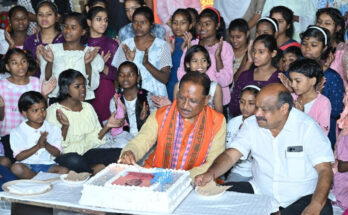Raipur, 27 July 2022
In Chhattisgarh, it is called Hareli Tihar, the gate of festivals. Hareli Tihar is the first festival of Chhattisgarh, which introduces people to the culture and faith of Chhattisgarh. Hareli festival is an agricultural festival. Hareli means greenery, which is celebrated every year on the new moon of the month of Sawan. Hareli is mainly a festival related to agriculture. It is celebrated with great enthusiasm by the rural farmers in the state of Chhattisgarh. Before this festival, farmers sow or transplant their crops and on this day all the agricultural implements like plow, pickaxe, spade, shovel, and all kinds of agricultural implements are cleaned and kept at one place. Keeping it and worshiping him. At home, women prepare different types of Chhattisgarhi dishes, especially jaggery cheela. In Hareli, where farmers worship agricultural implements and enjoy the dishes, coconut throwing competition among themselves,
The name of this popular festival is Hareli, derived from the Hindi word Hariyali. In the month of Shravan, there is a monsoon in India, due to which there is greenery all around due to rain. Huh.
During the Hareli festival, people plant branches of the Bhelwa tree in their respective fields, along with the branches of the neem tree are also planted at the entrance of the houses. Neem has medicinal properties that protect against diseases as well as insects. On this day, the people of the blacksmith caste, to protect the house from negative energies, put pai, which is a sharp iron nail, at every door of the house. After Hareli Tihar, the process of many festivals starts.
Amus festival is celebrated in Bastar region on Hariyali Amavasya. Amus festival is celebrated by the villagers of Bastar region by planting a thin stick of tendu tree along with medicinal herbs in their fields. On the upper end of this stick, Shatavar, Rasna Jadi, Keu tuber are tied in the leaves of Bhelwan. The belief of the villagers behind sticking this stick in the fields is that it protects the crop from the wrath of insects and other diseases. Herbs are also fed to cattle on this occasion. For this, preparations are made by the farmers a day in advance. Herbs brought from the forest include raspana, keu tubers, asparagus leaves and other vegetation, wrapped in leaves and fed to cattle. On this day the ritual of Rog Bohrani is also done. In which the villagers hang the broken bamboo soup-basket-broom and other things on the tree outside the village after use. In South Bastar, this festival is celebrated not only on Hariyali Amavasya in all the villages, but after that in the villages within the next fortnight, the day is celebrated.
In order to preserve and promote the culture of Chhattisgarh, in the course of important steps taken by the government during the last three and a half years, now public holidays are also given on local Teej-festivals. These include Hareli Tihar. The intention of the state government behind this is to connect the people of Chhattisgarh with its tradition and culture, so that people can feel proud of the rich art-culture, Teej-festivals and traditions of Chhattisgarh.
Due to Chhattisgarh being an agricultural staple, the festival of Hareli becomes even more important. Many schemes have been implemented by the state government for the development of agriculture, livestock and related to them, out of which Narva-Garwa-Ghurwa and Bari are prominent. Under which, construction of Gauthans in Gram Panchayats, purchase of cow dung, manufacture of organic manure, production of fruits and flowers in vegetables in traditional domestic gardens is being promoted.
To strengthen the rural economy by the state government, Godhan Nyay Yojana was started two years ago on the day of Hareli, the results of which are now being seen, the objective of this scheme is to provide employment opportunities to the people, improve the fertility of the land and To promote eutrophication, this scheme has given additional source of income to the cattle rearers. A new revolution has started in the state with the production and use of vermicompost from cow dung, a new confidence has arisen in women self-help groups towards self-reliance, electricity generation and natural paints are being made from cow dung.
Taking this chain forward, the state government is going to start the purchase of cow urine from Hareli Tihar at the rate of Rs 4 per liter in Gauthano this year. Women self-help groups will prepare Jeevamrut and pest control products from cow urine, which will promote organic farming. Farmers will be able to use pest control product made from cow urine instead of chemical insecticide.
Schemes like plantation incentives are also being run by the state government to move forward in the direction of eco-friendly development by connecting with nature, through which citizens are being encouraged to plant trees on private land to maintain greenery. With the new experiments of farming and economic empowerment, the state government is giving shape to its motto Garhbo Nava Chhattisgarh in the form of self-reliant villages.




